Much like a seven-course fine dining experience, THE DINNER PARTY feels luxurious; almost as if this is what velvet and crystal would look and feel like if translated into cinematic components. Written and directed by Miles Doleac and co-written by Michael Horn, THE DINNER PARTY is delectable… delicious… dark… and macabrely fun. The cinematic structure is solid and well done while cinematography soars. The tonal bandwidth of the film does a 180-degree shift from beginning to end as the story unfolds. As with any visually appealing and aromatic feast, it is impossible to look away. The senses and one’s own curiosity take hold and we are drawn into this story, a story that keeps us on tenterhooks, teasing out a simmering cinematic palette until it bubbles over into a frenzied cacophony of tastes in the form of big reveals and surprising twists.

Somewhat of a nebbish, and with more than an air of arrogance, playwright Jeffrey Duncan is looking for financing to bring his new play to Broadway. Angel financiers come in all shapes and sizes so when renowned surgeon and culinary enthusiast, Carmine Braun, invites Jeffrey and his wife Haley to his semi-annual exclusive dinner party with promises of investing in Jeffrey’s play, Jeffrey jumps at the invitation. Needless to say, the dinner guests are guaranteed to be somewhat eccentric but allegedly quite well-heeled and influential so Jeffrey is determined to make a good impression and get more than Carmine to open their checkbooks.

On Jeffrey’s arm is his wife Haley. A petite young thing, she is charming but nervous; the latter undoubtedly due to Jeffrey’s bullying demeanor towards her, commenting unkindly on her dress, criticizing her uneducated curiosity about a Pollack-esque piece of art on the wall, and pressing her about taking her medication. (Medication? Hmmm. . .) This attitude does not go unnoticed by Carmine’s somewhat childish, effeminate yet elegant friend, Sebastian, who scares the bejeezus out of Haley when answering the door wearing a frightening yet dazzling mask.

As the night gets underway, a curious cast of characters appears each one a bit more twisted than the next, making for an interesting collective. With all eyes on the unwitting Jeffrey and naive Haley, the true intention of this semi-annual gathering is slowly revealed in a rather macabre psychologically probing fashion, and all under the guise of refined elegance, culture, class, and appreciation for fine cuisine, secret rituals, and opera. And of course, what would a dinner party be without some form of entertainment.

The cast of characters of THE DINNER PARTY is served up as uniquely as the dinner courses themselves. As mentioned, there is opera-loving Sebastian, playing like a little boy trying to fit into his dad’s old suit, in this case with Carmine filling the bill as a paternal substitute. Carmine is elegance and ego personified with nary a hair out of place, even while preparing the evening’s delectables, the precision of his surgical skills always on display through the grace of his movements. Obviously Carmine’s BFF, we meet Vincent. Dashing and debonair with the flair and propriety of an upper-crust Brit, Vincent is perhaps the kindest and most tolerant of Haley’s worldly shortcomings. Each, however, has difficulty hiding their disdain for Jeffrey and his aura of self-importance and bullying tendencies towards Haley. Together, Carmine, Sebastian, and Vincent feel like a family; albeit maybe dysfunctional, but a family nonetheless. Rounding out the household is Sadie. Quiet, ethereal, mystic, earthly, and Edenesque. Carmine and Vincent have almost a reverence for her. Rounding out the dinner guests are Agatha and Tammy.

As Sadie, Lindsay Anne Williams (also serving as costume designer which explains the beauty of her costuming, and the varied costume changes) is perfection. Her cadence, her delivery, her utter and complete calm is ideal for this character and serves as a perfect counter to everyone else in the room. Sawandi Wilson as Sebastian is childish with his bickering, playing airplane with the food, slapping people. He truly embodies the idea of a little boy who doesn’t know how to grow up, doesn’t know what he wants, and is he trying to please daddy.

Perhaps best known for his role in “We Are What We Are”, there is no one who could play Carmine but for Bill Sage. He is incredible. Sage can go from refinement to rage with the spin of a dime. He is simply killer. But a real casting joy is seeing writer/director Miles Doleac slipping into the role of Vincent with the silken ease of a panther. As Vincent, Doleac adopts a somewhat Cockney accent and sounds so much like Jason Statham throughout the film that if one was only listening and hearing the dialogue, you’d swear it was Statham. Adding to Doleac’s performance is his physical nuance and costuming as Vincent. Dressed in elegant glistening brocade for his jacket, Vincent is clad in finery and boasts impeccable manners and equally impeccable posture. And when it comes to his monologues and soliloquies, one is riveted.
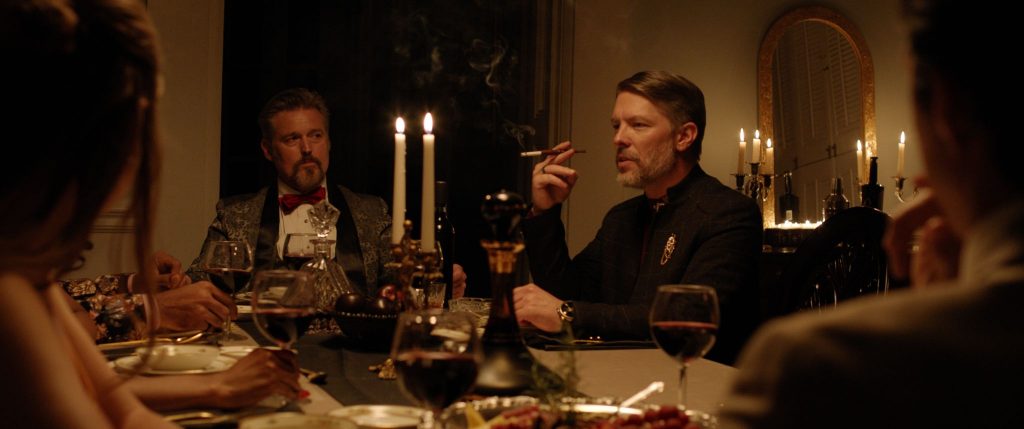
The real casting surprise, however, is Alli Hart as Haley. Running the gamut of emotion compounded with extreme physicality in the second half of the film and most notably the third act, Hart is spellbinding. We see the evening unfold through Haley’s eyes, her POV; something that shifts in perspective and intensity as the night progresses. All is never what it seems to be on the surface. THE DINNER PARTY is all about getting to the “heart” of the matter, the “meat” of desires and of life.
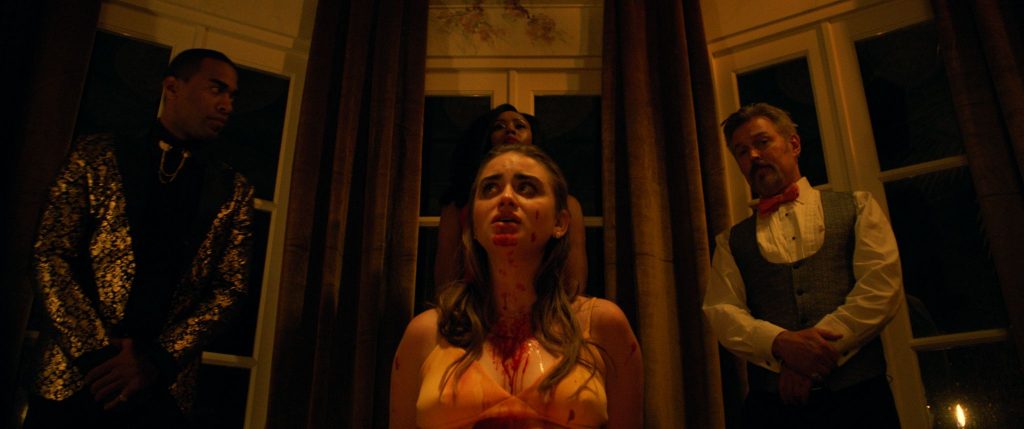
The visual aesthetic of THE DINNER PARTY looks to the paintings of Baroque and Rococo artists like Caravaggio or Ribera for inspiration in its look and feel, particularly with the layering of color and the intricate design of negative space within the context of the story. The film’s color palette is darker, relying on dark golds, metallic threads and brocades, and various shades of red that range from an almost coagulated brownish-red to bright cherry. The only color contrast that we find throughout comes with the character of Sadie who is clad in shimmering shades of green creating a beautiful metaphor of life contrasting the reds of death or life-giving blood. Continuing to play with color, Haley is clad in a salmon tone that falls between reds, golds, and greens on a color wheel. Like her signature color, Haley is the bridge between life and death at THE DINNER PARTY.

The use of color directly impacts cinematographer Michael Williams’ lighting and lensing as it both inhibits and energizes the frame. As the film progresses, with core color elements intact, lighting and lensing celebrate negative space. The blackness is inky, rich, and velvety. The negative space is glorious, telling us as much about this dinner party and these people as anything. It lures us into the darkness. It has a textured velvety feel to it, leading one to believe everything is going to be nice, plush, and delicious. But the theatricality of the lighting and the creation of negative space is deceiving. We don’t know what’s going on in the background and Doleac and Williams may or may not be diverting our attention and curiosity as to what is really happening. We are kept on our toes, salivating, waiting for the next course.
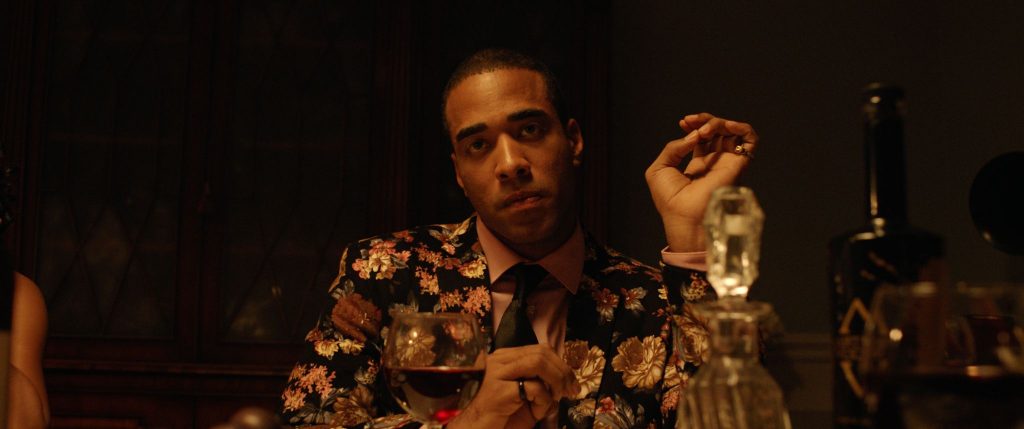
Contained within this mansion for 95% of the film, which bodes well for control and attention to detail within the production design and set dress, when we do venture outside for an extended time in the third act, we are met with an explosion of blues and underwater lighting from a pool which is then punctuated with crimson and highlighted within a sliver of moonlight capturing the steam rising from the heated water. Gorgeous, literally and figuratively. These are some of the real money shots within the film.
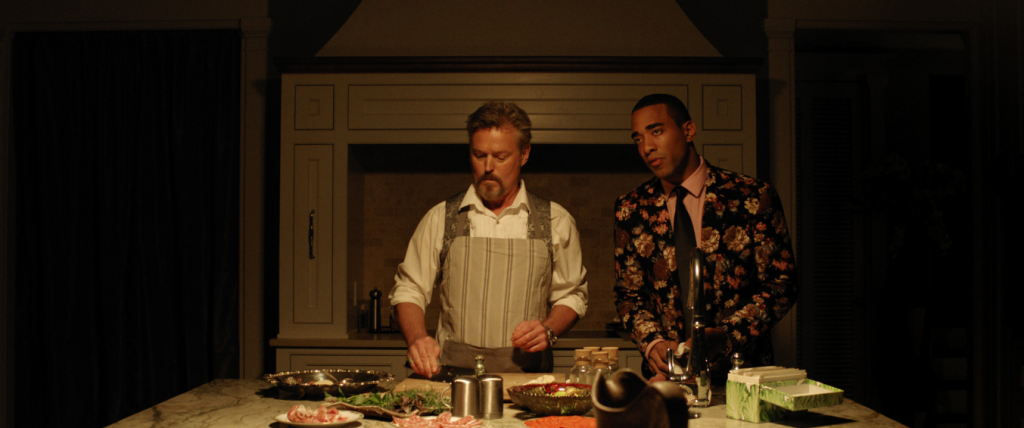
Notable is how the ambient color palette of the film changes from beginning to end with mirroring shots employed but with the feel of the film going from warmer golds to cooler, bluish whites. The velvety inkiness of darkness dissipates. The reason why is told through the unfolding story and action.
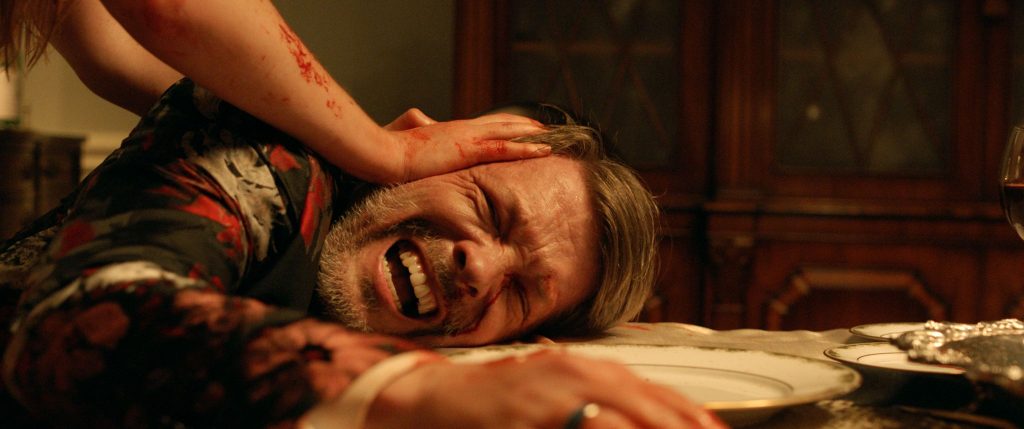
Interesting is the camera movement. During a lively action sequence, the camera is steady but trained on Haley and as she starts to move, the camera pans. This mirrors an earlier introductory pan of the dinner table as we meet each guest. During those table pans, we not only stay in Haley’s POV but the camera is almost level with the tabletop, allowing for Williams to give us interesting angles around the room as he plays with the focal length of foreground and background. He keeps us in the moment but on edge. Close-ups are kept to a minimum. Framing is primarily mid and mid-two shots so we see action and reaction in the same frame without back and forth coverages. But when ECU’s are used, they are meaningful and striking.
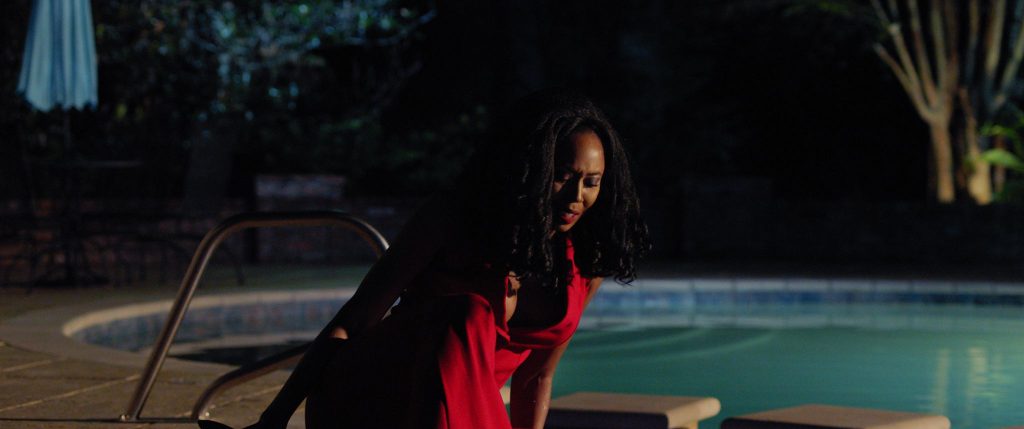
Notable is the attention to detail by Doleac and his production designer Julie Toche. We don’t need watches or clocks as we see the passage of time thanks to candles on the dining room table as they burn down. We are steeped in the elegance of Carmine’s world thanks to candle holders, the tabletop candelabras themselves, crystal decanters sitting on a buffet, a martini shaker, formal place settings of china that is simple yet elegant. Each touch defines who Carmine and his friends are.
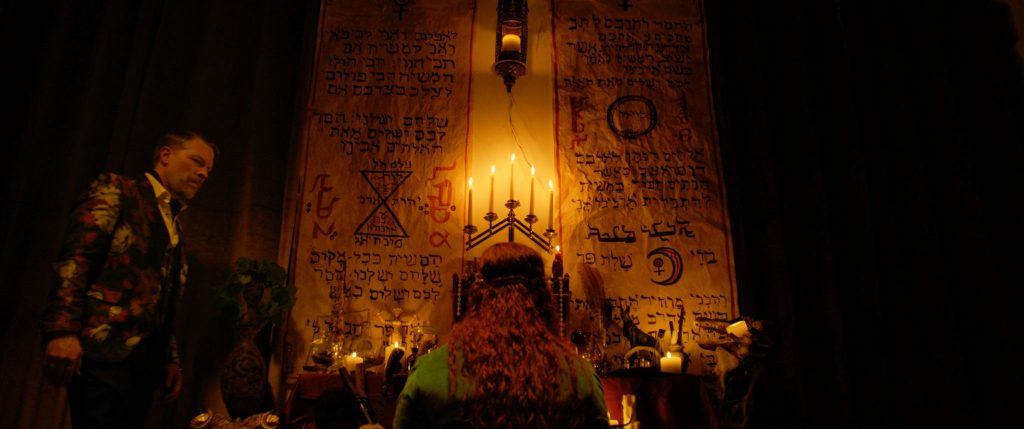
Pacing is key because the pacing of the film is opposite the cadence and pacing of the characters in their dialogue, particularly Sadie, who is contrary to everything else in the film. Keith Jared Hollingsworth does an amazing job with the editing, from building tension to explosive action and finding a believable and resonant balance.

Icing on the cake is the work of composer Clifton Hyde, who composed the score to this film and created a perfect blend of score and opera, delivering a rhythmic heartbeat that pulsates, while adding an opening touch of whimsy thanks to the use of the bass clarinet or a bassoon. Score signals “the game’s afoot” and takes us through every play of the game. The entire musical presentation has a wonderful complexity thanks to the operatic framework with original scoring.
Visually rich and luxurious, creative in character and story, THE DINNER PARTY is one dinner you don’t want to miss. Just make sure to stay for dessert.
Written and Directed by Miles Doleac
Co-written by Michael Horn
Cast: Bill Sage, Sawandi Wilson, Miles Doleac, Lindsay Anne Williams, Alli Hart, Mike Mayhill, Jeremy London, Kamille McCuin
by debbie elias, 03/30/2020











